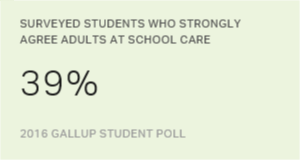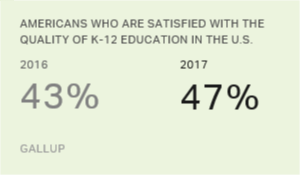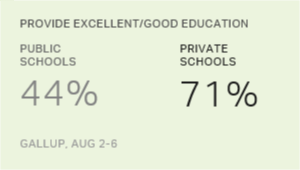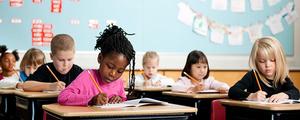Story Highlights
- 85% of U.S. parents send their child to public school
- Regular churchgoers, upper-income, postgrads least likely to do so
- Lower-income, nonreligious most likely to have a child in public school
WASHINGTON, D.C. -- Eighty-five percent of U.S. parents of school-aged children have a child in public school, while 9% send their child to private school, 3% send theirs to parochial school and 3% home-school. Regular churchgoers, those with postgraduate education and upper-income adults are the least likely subgroups of parents to send their child to public school, while lower-income and nonreligious parents are the most likely.
| Public school | Private school | Parochial school | Home school | |||||||||||||||||||||||||||||||||||||||||||||||||||||||||||||||||||||||||||||||||||||||||||||||||
|---|---|---|---|---|---|---|---|---|---|---|---|---|---|---|---|---|---|---|---|---|---|---|---|---|---|---|---|---|---|---|---|---|---|---|---|---|---|---|---|---|---|---|---|---|---|---|---|---|---|---|---|---|---|---|---|---|---|---|---|---|---|---|---|---|---|---|---|---|---|---|---|---|---|---|---|---|---|---|---|---|---|---|---|---|---|---|---|---|---|---|---|---|---|---|---|---|---|---|---|---|
| % | % | % | % | |||||||||||||||||||||||||||||||||||||||||||||||||||||||||||||||||||||||||||||||||||||||||||||||||
| All U.S. parents | 85 | 9 | 3 | 3 | ||||||||||||||||||||||||||||||||||||||||||||||||||||||||||||||||||||||||||||||||||||||||||||||||
| Least likely to send child to public school | ||||||||||||||||||||||||||||||||||||||||||||||||||||||||||||||||||||||||||||||||||||||||||||||||||||
| Attend church weekly | 78 | 11 | 5 | 4 | ||||||||||||||||||||||||||||||||||||||||||||||||||||||||||||||||||||||||||||||||||||||||||||||||
| Postgraduate education | 79 | 13 | 6 | 2 | ||||||||||||||||||||||||||||||||||||||||||||||||||||||||||||||||||||||||||||||||||||||||||||||||
| Household income $75,000+ | 79 | 13 | 5 | 2 | ||||||||||||||||||||||||||||||||||||||||||||||||||||||||||||||||||||||||||||||||||||||||||||||||
| College graduate only | 80 | 12 | 4 | 4 | ||||||||||||||||||||||||||||||||||||||||||||||||||||||||||||||||||||||||||||||||||||||||||||||||
| Catholic | 81 | 9 | 7 | 1 | ||||||||||||||||||||||||||||||||||||||||||||||||||||||||||||||||||||||||||||||||||||||||||||||||
| Republican | 81 | 11 | 4 | 4 | ||||||||||||||||||||||||||||||||||||||||||||||||||||||||||||||||||||||||||||||||||||||||||||||||
| Conservative | 81 | 10 | 4 | 5 | ||||||||||||||||||||||||||||||||||||||||||||||||||||||||||||||||||||||||||||||||||||||||||||||||
| Most likely to send child to public school | ||||||||||||||||||||||||||||||||||||||||||||||||||||||||||||||||||||||||||||||||||||||||||||||||||||
| Household income <$30,000 | 90 | 6 | 2 | 2 | ||||||||||||||||||||||||||||||||||||||||||||||||||||||||||||||||||||||||||||||||||||||||||||||||
| No religious preference | 89 | 6 | 2 | 3 | ||||||||||||||||||||||||||||||||||||||||||||||||||||||||||||||||||||||||||||||||||||||||||||||||
| Seldom/Never attend church | 89 | 7 | 2 | 2 | ||||||||||||||||||||||||||||||||||||||||||||||||||||||||||||||||||||||||||||||||||||||||||||||||
| Hispanic | 88 | 8 | 1 | 2 | ||||||||||||||||||||||||||||||||||||||||||||||||||||||||||||||||||||||||||||||||||||||||||||||||
| Based on aggregated data from 2001-2017 Gallup Work and Education polls | ||||||||||||||||||||||||||||||||||||||||||||||||||||||||||||||||||||||||||||||||||||||||||||||||||||
| Gallup | ||||||||||||||||||||||||||||||||||||||||||||||||||||||||||||||||||||||||||||||||||||||||||||||||||||
These results are based on aggregated data from Gallup's Work and Education poll, conducted annually since 2001. As part of the survey, Gallup asks parents of K-12 students whether their oldest child attends public, private or parochial school or is home-schooled. The aggregated 2001-2017 data include responses from more than 4,500 K-12 parents.
Overall, the results show that the vast majority of parents, regardless of demographics, send their child to public school. But the type of school that parents send their child to does vary by religion, income and educational attainment.
The relationship between household income and school choice is obvious. Upper-income parents have the financial means to pay private school tuition, and lower-income parents do not.
Income could also explain the relationship between educational attainment and choice of school, as parents with postgraduate education earn more on average than those with less formal education. But postgraduates, regardless of income, might place an especially high value on formal education, and thus be more likely to consider alternatives to public school for their child.
Parents with a strong religious faith may want their children to attend a school where prayer is permitted and faith and morality are taught in addition to standard academic subjects. In contrast, parents who are not religious may more readily embrace the secular instruction that U.S. public schools provide.
Political and ideological orientation also appear to affect whether parents send their children to public school, as Republicans and conservatives are among the groups least likely to have a child in public school. To some degree, this reflects the relationship between religiosity and political identification. It also may be a result of Republicans' and conservatives' less positive views of public schools.
One in Eight Postgrads, Upper-Income Send Child to Private School
After public schooling, private schooling is the next most common way U.S. children are educated, with 9% of K-12 students attending private school -- which may include private, non-church-affiliated schools as well as charter schools. The meaning of the word "private" is left to the interpretation of the respondent.
Overall, 13% of parents with postgraduate education, and an equal percentage of upper-income parents, send their child to private school. Parents with a four-year college degree and no postgraduate studies are also among the groups more likely to have a child in private school. Other subgroups exceeding the national average for having a child in private school include Southerners, city dwellers, Republicans and regular churchgoers.
| Child in private school | |||||||||||||||||||||||||||||||||||||||||||||||||||||||||||||||||||||||||||||||||||||||||||||||||||
|---|---|---|---|---|---|---|---|---|---|---|---|---|---|---|---|---|---|---|---|---|---|---|---|---|---|---|---|---|---|---|---|---|---|---|---|---|---|---|---|---|---|---|---|---|---|---|---|---|---|---|---|---|---|---|---|---|---|---|---|---|---|---|---|---|---|---|---|---|---|---|---|---|---|---|---|---|---|---|---|---|---|---|---|---|---|---|---|---|---|---|---|---|---|---|---|---|---|---|---|
| % | |||||||||||||||||||||||||||||||||||||||||||||||||||||||||||||||||||||||||||||||||||||||||||||||||||
| Postgraduate education | 13 | ||||||||||||||||||||||||||||||||||||||||||||||||||||||||||||||||||||||||||||||||||||||||||||||||||
| Household income $75,000+ | 13 | ||||||||||||||||||||||||||||||||||||||||||||||||||||||||||||||||||||||||||||||||||||||||||||||||||
| College graduate only | 12 | ||||||||||||||||||||||||||||||||||||||||||||||||||||||||||||||||||||||||||||||||||||||||||||||||||
| Live in South | 11 | ||||||||||||||||||||||||||||||||||||||||||||||||||||||||||||||||||||||||||||||||||||||||||||||||||
| Live in a city | 11 | ||||||||||||||||||||||||||||||||||||||||||||||||||||||||||||||||||||||||||||||||||||||||||||||||||
| Republican | 11 | ||||||||||||||||||||||||||||||||||||||||||||||||||||||||||||||||||||||||||||||||||||||||||||||||||
| Attend church weekly | 11 | ||||||||||||||||||||||||||||||||||||||||||||||||||||||||||||||||||||||||||||||||||||||||||||||||||
| Based on aggregated data from 2001-2017 Gallup Work and Education polls | |||||||||||||||||||||||||||||||||||||||||||||||||||||||||||||||||||||||||||||||||||||||||||||||||||
| Gallup | |||||||||||||||||||||||||||||||||||||||||||||||||||||||||||||||||||||||||||||||||||||||||||||||||||
Three percent of U.S. parents have a child in parochial school. Catholic parents are most likely to be in this group, which is not surprising given the large number of Catholic parochial schools in the U.S. As is the case for private school, parochial parents tend to live in higher-income households and to have postgraduate education. Sending a child to parochial school is also more common among older parents (those aged 50 to 64) and those living in the Midwest.
| Child in parochial school | |||||||||||||||||||||||||||||||||||||||||||||||||||||||||||||||||||||||||||||||||||||||||||||||||||
|---|---|---|---|---|---|---|---|---|---|---|---|---|---|---|---|---|---|---|---|---|---|---|---|---|---|---|---|---|---|---|---|---|---|---|---|---|---|---|---|---|---|---|---|---|---|---|---|---|---|---|---|---|---|---|---|---|---|---|---|---|---|---|---|---|---|---|---|---|---|---|---|---|---|---|---|---|---|---|---|---|---|---|---|---|---|---|---|---|---|---|---|---|---|---|---|---|---|---|---|
| % | |||||||||||||||||||||||||||||||||||||||||||||||||||||||||||||||||||||||||||||||||||||||||||||||||||
| Catholic | 7 | ||||||||||||||||||||||||||||||||||||||||||||||||||||||||||||||||||||||||||||||||||||||||||||||||||
| Postgraduate | 6 | ||||||||||||||||||||||||||||||||||||||||||||||||||||||||||||||||||||||||||||||||||||||||||||||||||
| 50-64 years old | 6 | ||||||||||||||||||||||||||||||||||||||||||||||||||||||||||||||||||||||||||||||||||||||||||||||||||
| Live in Midwest | 6 | ||||||||||||||||||||||||||||||||||||||||||||||||||||||||||||||||||||||||||||||||||||||||||||||||||
| Household income $75,000+ | 5 | ||||||||||||||||||||||||||||||||||||||||||||||||||||||||||||||||||||||||||||||||||||||||||||||||||
| Based on aggregated data from 2001-2017 Gallup Work and Education polls | |||||||||||||||||||||||||||||||||||||||||||||||||||||||||||||||||||||||||||||||||||||||||||||||||||
| Gallup | |||||||||||||||||||||||||||||||||||||||||||||||||||||||||||||||||||||||||||||||||||||||||||||||||||
An increasing number of U.S. children are home-schooled, with an average of 3% of children taught at home, up from 1% in 2000. In contrast to the demographic patterns seen with private and parochial school parents, home-schooling rates are below the national average for parents with postgraduate education (2%) or higher household incomes (2%).
Rather, home schooling is related to other factors such as where parents live and their religious and political outlooks. Home schooling is slightly more common among parents who live in towns or rural areas and among those who are politically conservative. Protestants, Republicans, regular churchgoers and college graduates (with no postgraduate education) also are more likely than other parents to home-school their child.
| Child in home-school | |||||||||||||||||||||||||||||||||||||||||||||||||||||||||||||||||||||||||||||||||||||||||||||||||||
|---|---|---|---|---|---|---|---|---|---|---|---|---|---|---|---|---|---|---|---|---|---|---|---|---|---|---|---|---|---|---|---|---|---|---|---|---|---|---|---|---|---|---|---|---|---|---|---|---|---|---|---|---|---|---|---|---|---|---|---|---|---|---|---|---|---|---|---|---|---|---|---|---|---|---|---|---|---|---|---|---|---|---|---|---|---|---|---|---|---|---|---|---|---|---|---|---|---|---|---|
| % | |||||||||||||||||||||||||||||||||||||||||||||||||||||||||||||||||||||||||||||||||||||||||||||||||||
| Live in town or rural area | 5 | ||||||||||||||||||||||||||||||||||||||||||||||||||||||||||||||||||||||||||||||||||||||||||||||||||
| Conservative | 5 | ||||||||||||||||||||||||||||||||||||||||||||||||||||||||||||||||||||||||||||||||||||||||||||||||||
| Protestant | 4 | ||||||||||||||||||||||||||||||||||||||||||||||||||||||||||||||||||||||||||||||||||||||||||||||||||
| Republican | 4 | ||||||||||||||||||||||||||||||||||||||||||||||||||||||||||||||||||||||||||||||||||||||||||||||||||
| College graduate only | 4 | ||||||||||||||||||||||||||||||||||||||||||||||||||||||||||||||||||||||||||||||||||||||||||||||||||
| Attend church weekly | 4 | ||||||||||||||||||||||||||||||||||||||||||||||||||||||||||||||||||||||||||||||||||||||||||||||||||
| Based on aggregated data from 2001-2017 Gallup Work and Education polls | |||||||||||||||||||||||||||||||||||||||||||||||||||||||||||||||||||||||||||||||||||||||||||||||||||
| Gallup | |||||||||||||||||||||||||||||||||||||||||||||||||||||||||||||||||||||||||||||||||||||||||||||||||||
Bottom Line
Public schools remain the dominant way U.S. children are educated. This is the case even though Americans rate the quality of public school education worse than its alternatives. Public school parents themselves are much less likely than private school parents to say they are completely satisfied with their child's education.
Certainly, many parents may not have the financial means to send their children to private school even if they wanted to, one of the arguments made in favor of federal, state or local school choice programs. Also, many parents who can afford private school may live in areas with highly regarded public school systems that they believe will give their children a quality education that is tuition-free.
For many parents, the choice of whether to send their children to public school comes down to economics. But many other parents appear to choose alternatives to public school because of religious or political reasons.
Donald Trump's administration, like George W. Bush's, is attempting to expand school choice options for parents. But the school choice debate is politically charged, and Trump succeeding in enacting such changes is far from assured.

Optimize Your School
Engage students to help them get the most out of their education.
Survey Methods
Results for this Gallup poll are based on combined telephone interviews from Gallup's annual Work and Education survey, conducted each August from 2001 to 2017. The combined sample is based on interviews with 4,572 randomly selected adults, aged 18 and older, living in all 50 U.S. states and the District of Columbia who have a child in grades K-12. For results based on this sample of national adults, the margin of sampling error is ±2 percentage points at the 95% confidence level.
All reported margins of sampling error include computed design effects for weighting.
View survey methodology, complete question responses and trends.
Learn more about how the Gallup Poll Social Series works.




